Apple's 2010 MacBook Air (11 & 13 inch) Thoroughly Reviewed
by Anand Lal Shimpi on October 26, 2010 10:08 PM EST- Posted in
- Mac
- Apple
- MacBook Air
- Laptops
The 11-inch MacBook Air: Faster than the old 13-inch MacBook Air
On paper, the new 13-inch MacBook Air shouldn’t be any faster than the old 2008 MacBook Air - at least in CPU bound tasks. The 2010 model gets a faster GPU but the CPU is literally the same 1.86GHz Core 2 Duo. Memory sizes and speeds haven’t changed either. While the SSD is faster, if you’re running a CPU bound benchmark there shouldn’t be any performance difference. If you assumed the same thing I did, you’d be very wrong.
Take a look at Cinebench 11 comparing the 2008 13-inch MacBook Air to the two 2010 models:
| Cinebench 11 - Multithreaded CPU Benchmark | |||||
| 11-inch MacBook Air (2010) - 1.4GHz Core 2 Duo | 13-inch MacBook Air (2010) - 1.86GHz Core 2 Duo | 13-inch MacBook Air (2008) - 1.86GHz Core 2 Duo | |||
| Cinebench 11 Score (Higher is Better) | 0.81 | 1.1 | 0.70 | ||
Not only is the 2008 13-inch MBA slower than the new 13-inch model, it’s actually slower than the 11-inch model running at 1.4GHz. Something is amiss. Perhaps it’s just this benchmark?
I turned to our Handbrake H.264 encode test to verify my sanity:
| Handbrake 0.94 - H.264 High Profile Transcode | |||||
| 11-inch MacBook Air (2010) - 1.4GHz Core 2 Duo | 13-inch MacBook Air (2010) - 1.86GHz Core 2 Duo | 13-inch MacBook Air (2008) - 1.86GHz Core 2 Duo | |||
| Average Frames per Second (Higher is Better) | 1.14 fps | 1.55 fps | 0.96 fps | ||
Once again, a similar situation. The old MBA is actually slower than the new 11-inch, despite the advantage in CPU speed.
It looks like what we’ve stumbled upon is a combination of Apple aggressively throttling the clock speed of the older MacBook Air CPUs to meet thermal requirements, and the CPUs used in the new MacBook Airs being far better behaved from a voltage/power consumption standpoint.
The 45nm process these Core 2s are built on is as mature as it’s going to get. I’m guessing yield on these parts is as high as can be and as a result, power consumption is probably consistently lower than the original 1.86GHz parts Apple shipped back in 2008. The peak thermal specs themselves haven’t changed, but the actual power characteristics have.
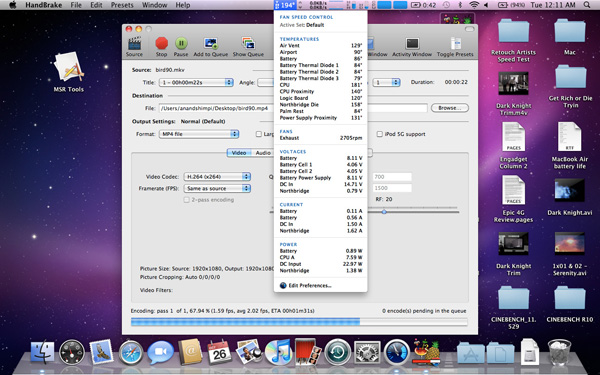
The 2008 MacBook Air under Load
Maximum temperature, at least reported by the MBA’s sensors, isn’t any lower on the new 13-inch than the 2008 I compared it to. Both CPUs hit roughly 84C (183F) under full load. But look at what happens to the chips after a minute at that load:
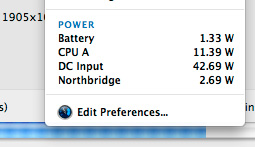 2010 13-inch MacBook Air |
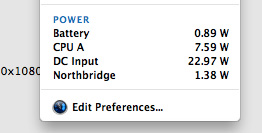 2008 13-inch MacBook Air |
iStat Menus reports the 1.86GHz Core 2 Duo in the 2008 system consuming only 7.59W, while the same CPU in the 2010 machine is drawing 11.45W. The 2008 machine is throttling back to reduce overall temperature while the 2010 system keeps going.
As a result, even the 11-inch MacBook Air will probably end up being as fast, if not faster than the 2nd generation 2008 13-inch MacBook Air. And our performance results confirm that:
| 11-inch MacBook Air (2010) vs. 13-inch MacBook Air (2008) | ||||||||
| Application Launch Test | Adobe Photoshop CS4 | Aperture RAW Import | Cinebench R10 - 1CPU | Cinebench R10 - XCPU | Quicktime H.264 Transcode | |||
| Apple 11-inch MacBook Air (2010) - 1.4GHz Core 2 Duo | 27.8 seconds | 72.4 seconds | 1.29 PPS | 1612 | 2967 | 33.1 fps | ||
| Apple 13-inch MacBook Air (2008) - 1.86GHz Core 2 Duo | 26.4 seconds | 71.3 seconds | 1.20 PPS | 2046 | 2882 | 30.1 fps | ||
You'll notice the less CPU intensive tasks are quicker on the old 13-inch system as the CPU isn't able to get hot enough to trigger Apple's throttling. The single threaded Cinebench test is the best example of this. The 26% performance advantage jibes with the 33% increase in CPU clock speed (it's actually a little low, most likely because the old CPU still isn't running at full speed even in this test). But now look at the heavier tests - the multithreaded Cinebench test and the Quicktime encode. Both of these stress both cores and drive TDP up, which forces Apple to pull clock speed back down. We wondered how Apple was able to cram such a high speed CPU into such a thin chassis as early as it did, now we know.
In practice I found the 2008 13-inch MBA launched applications quicker (short bursts of full clock speed), but after prolonged use or completing CPU intensive tasks it was tough to tell apart from the new 11-inch. What's even more troublesome is that Apple's aggressive clock throttling went relatively undetected until now. This is something I'm going to have to devise tests for and pay more attention to in future reviews. Sneaky, Steve, sneaky.
External Temperatures and Noise
The old MacBook Air chassis had a few dozen slits cut out of the aluminum for ventilation. The new MacBook Air chassis hides the ventilation slits between the base of the unit and the hinge. You can’t see them, but they’re there.
The slits are smaller than they were on the old chassis, which means moving air through them at the same rate sounds louder than before.
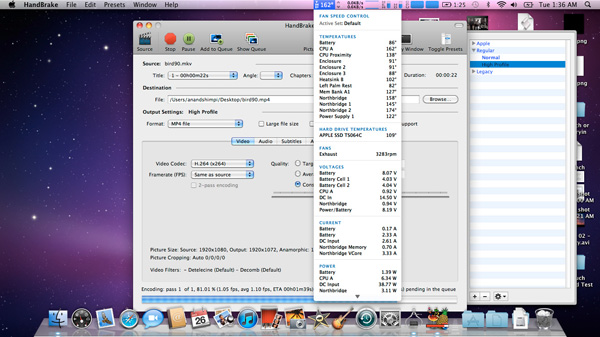
The 11-inch MacBook Air under Load
The CPU in the 11-inch model, even when under heavy loads, likes to stay at or below 72C (162F). At that temperature, the internal fan doesn’t spin above 4000 RPM (usually down below 3400). The 13-inch MacBook Air however is far more likely to generate noise. Running our simple Handbrake test the CPU will peak at over 82C (~180F) and the system’s internal fan will ramp up to over 6K RPM to compensate. Not only does the chassis get hot, but the fan gets audible. It’s still too small of a fan to really be considered loud in the grand scheme of things, but it’s loud enough to be annoying.
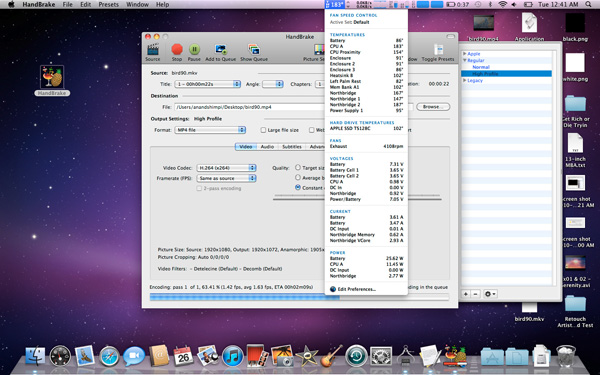
The 13-inch Macbook Air under Load
The surface temperature of the new 13-inch MacBook Air easily gets as high as the 2008 model. I measured a peak of 38.9C (102F) on both the 2008 and 2010 13-inch models. The 11-inch never broke 38C (100F).
Even casual use can ramp up temperatures pretty quickly. Just having a few websites open in the background that use Flash or other CPU intensive elements can slowly cause the MBA’s internal temperatures to rise. And now you’re beginning to see why Apple doesn’t install Flash on these things by default.
The danger zone is the upper left corner of the system, near the hinge. There’s only a single fan that cools both the CPU and GPU in the Air’s very tight enclosure. This is where that fan sits.










185 Comments
View All Comments
VanHoward - Wednesday, October 27, 2010 - link
Instead of "jives with" should be "jibes with" ...Exelius - Wednesday, October 27, 2010 - link
I'm a huge Apple fan - but I'm just not drinking the kool-aid on this one.I have a 15" MBP and it's really not that bad to carry around. It also gets like 5-8 hours of battery life (3-4 with VMWare running) and it runs Windows 7 under VMware very well with 8 GB of RAM. I've never considered portability an issue and while it's an expensive machine, I don't think you'd own an MBA. I doubt the MBA would have nearly that type of battery life under VMWare.
The iPad seems like a better form factor for the "couch computer" (i.e. looking up shit on IMDB or googling something to settle an argument while watching football.)
IMO the MBA seems like a poor man's MBP. i.e. for students looking for a cheaper computer; the "super-thin" part seems almost like a gimmick to convince people it's a premium product. Really, the only drawback of the 15" MBP (even the lowest-specced one) is the price.
joe_dude - Wednesday, October 27, 2010 - link
The thing's hardly faster than my Ion netbook. There will be lots of thin designs coming out like what Intel showed at Computex. Core 2's two generations behind.For now, I think the Acer TimeLineX 3820TG is still the best ultraportable laptop (certainly the fastest anyway).
zsero - Wednesday, October 27, 2010 - link
As for an alternative for sub 5 lbs powerful laptops and as for the M11x being fast: I am typing this line on a Acer TimelineX 3820TG with 450M and switchable HD5650, which is on a totally different level than either the MBA or the Dell (while being half the price).- 3.9 lbs
- it can do 9000-10000 points in 3dmark06 easily with a little bit of raised clocks (one click in AMD GPU tool). In games it's even faster, as the ATI cards are much better in real games than in benchmarks.
- if you are lucky, you can overclock CPU to 3.3 Ghz (or swap to a 580M and OC-it to 3.8 Ghz, with sub-75C temperatures!)
- and easily do 6-8 hours while web surfing
- has dual fan / dual heatpipe cooling
Other than that, it has the most horrible keyboard I have ever seen, with a cheap AUO screen, noisy mic and poor warranty service and a gazillion of running applications, including two real-time virus scanners on the factory install. But a review would be really interesting to see! I seriously think the 3820TG with HD5650 is without alternative in the powerful but portable notebooks, if possible, please make a review about it! (in North America, I think it's only available with 370M processor, while in Asia they sell it with anything up to 640M).
khimera2000 - Wednesday, October 27, 2010 - link
Intresting system, but i wouldent use it. the keyboard looks to have flex under light loads, making me think that although it looks great on the outside the inside might of had to make some structual sacrifices for the bigger specs, not to mention that the lack of a backlit keyboard would make it more inconveniant compared to what i have now.But it does like they are trying to improve there build quality, its just not to the point that i would like.
As nice as the specs are, i just cant bring myself to trust there build quality just yet, however it does look like there at least trying to improve so who knows perhaps there will be an acer on my list of potentials the next time im do for a notebook upgrade.
as for comparison to the air... i think there oppisets in some respects. the air's performance although weak at best can still fit in nearly any bag making it conveniant to find a place to stow it for those who have bags full of books and junk, where as the acer trys to push for a more heavy multimedia experiance with a good compact form facter and a extended battery.
lemonadesoda - Wednesday, October 27, 2010 - link
1/ SD card reader2/ mic on front for skype/VoIP
The 11" netbook would be a absolute winner (and an order of magnitude upgrade for people using Atom netbooks) . But why did they miss the SD card reader? This is so obvious, and a determining feature what makes one brand/model of netbook a winner over another brand/model. Such a simple and cheap port. Even the iPad has an SD card reader!
And what on earth are they doing putting the mic on the side like that? While it *might* be OK when sitting indoors at a tidy desk without other ambient noise, it certainly is not clever in most "real world" situations.
I would love to replace my ever-so-slightly too noisy and underpowered (but magnificent screen and full of ports) SONY W11 netbook. But no, not until Apple fix the mic location and provide an SD slot.
(I use SD slot for camera - saving local or uploading to fileserver/website, for camcorder - and immediate playback of material recorded, for old-fashioned mailing of data/documents, for a TASCAM HQ digital audio recorder, and for file transfer with colleagues and for file backup when out of the office, I need highest possible robust mic for indoor and outdoor skype/VoIP where my office telephone is forwarded to my laptop through SIP )
These two points may seem like tiny features, but I think for many people they are showstoppers.
johnspierce - Wednesday, October 27, 2010 - link
I'm not sure why everyone thinks an SD card slot is a "must have". For one thing, there are still quite a few cameras that *don't* use SD cards (like virtually any high-end DSLR) and putting a technology in your laptop that might not even be viable in 3-5 years is not exactly a good idea. Buy a 9-in-1 card reader. They are like $20. They are about the size of a deck of cards and can handle almost any type of flash.I would MUCH rather have a 3.0 USB than a SD card slot -- infinitely more useful.
kmmatney - Wednesday, October 27, 2010 - link
SD slots are useful for permanent storage. I have an 80GB SSD in my Dell Inspiron 9400 laptop, but needed a little more storage. So I just keep a 32 GB card in the SD slot, and it gave me enough room for everything I need. I use it mainly for documents, presentations, and backups of important work from teh SSD. It only sticks out about 2 mm, so I can keep it on all the time. I've even run VMware images from it, and it wasn't too bad.I agree that a USB 3.0 slot is useful as well, but wouldn't want to lose the SD slot - its like having a second, easily removable, hard drive.
khimera2000 - Wednesday, October 27, 2010 - link
I see it as a replacemenct for the optical drive, since its also used in cameras, video recorders, and ebook readers (i have an SLR that uses these and a ebook) it makes them alot more conveniant since most notebooks come with the slot already. it puts the macbook at a disadvantage becaus now people have to carry around a card reader that would not be neaded on other notebooks.It would be such an inconveniance if i had to drag around a reader with me, and since alot of apple users do photo and video editing it looks like a bad oversight not being able to transfer images and videos without extra required hardware.
Stuka87 - Wednesday, October 27, 2010 - link
So I am posting late here. I read this last night, but was too tired to respond.So now a lot has already been said. But here is one thing that keeps boggling me.
WHY do people keep calling this a Netbook when it clearly *IS NOT*. The 11.6" MBA is an ultraportable. In line with other ultraportables out there. Its not a cheap piece of plastic with a laughable screen, keyboard, graphics, or atom processor. The benchmarks clearly show this machine to run circles around an atom.
And if you compare it to similar machines of weight, size, and speed its not far off the mark from a price concern either.
Is it a perfect machine, no... But it looks like it will fill the gap that has been missing from the Apple product line since the demise of the 12" PowerBook.